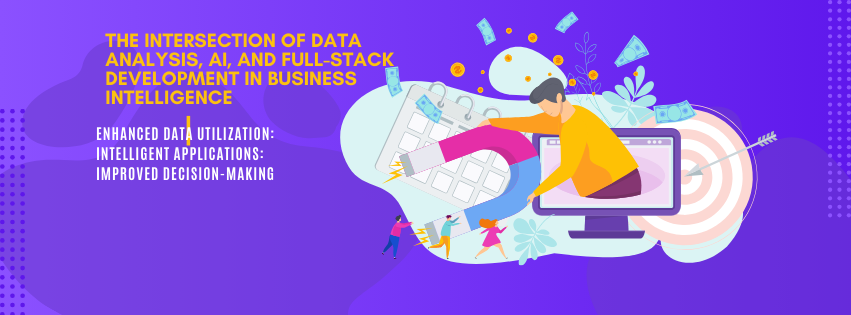In today’s digital age, the convergence of data analysis, artificial intelligence (AI), and full-stack development is transforming the way businesses operate. Understanding the interplay between these domains can help professionals leverage their skills to drive innovation and efficiency. This article delves into the critical roles of data analysts, the advancements in artificial intelligence, and the comprehensive approach of full-stack development, with some unique insights into their synergy in business intelligence.
1.1.1.1 The Role of Data Analysts in Business Intelligence
Data analysts play a pivotal role in interpreting and transforming data into actionable insights. Their primary responsibilities include:
- Data Collection and Cleaning: Data analysts gather data from various sources and ensure its accuracy by cleaning and organizing it.
- Statistical Analysis: They apply statistical techniques to identify trends, patterns, and relationships within data sets.
- Data Visualization: By creating visual representations of data, such as charts and graphs, data analysts help stakeholders understand complex information easily.
- Reporting: They compile reports that summarize their findings and provide recommendations based on data analysis.
Unique Insight: The Role of Data Analysts in Ethical AI
Data analysts are increasingly involved in ensuring the ethical use of data in AI applications. By identifying and mitigating biases in data, they help create fairer and more transparent AI systems. This role is becoming crucial as organizations strive to meet ethical standards and regulatory requirements.
1.1.1.2 Advancements in Artificial Intelligence for Business Intelligence
Artificial intelligence is revolutionizing various industries by enabling machines to perform tasks that typically require human intelligence. Some key advancements in AI include:
- Machine Learning: Machine learning algorithms allow systems to learn from data and improve their performance over time without explicit programming.
- Natural Language Processing (NLP): NLP enables machines to understand and process human language, making it possible to develop applications like chatbots and virtual assistants.
- Computer Vision: This technology allows machines to interpret and make decisions based on visual data, leading to innovations in fields such as healthcare and autonomous vehicles.
- Predictive Analytics: AI-powered predictive analytics can forecast future trends based on historical data, helping businesses make proactive decisions.
Unique Insight: AI in Human-Computer Interaction (HCI)
AI is enhancing human-computer interaction by making interfaces more intuitive and responsive. For instance, AI-driven voice recognition systems and personalized user interfaces are creating more seamless interactions between users and technology. This evolution is pivotal in developing next-generation user experiences.
1.1.1.3 The Comprehensive Approach of Full-Stack Development in Business Intelligence
Full-stack development refers to the ability to work on both the front-end and back-end aspects of a web application. Full-stack developers possess a broad skill set that includes:
- Front-End Development: This involves creating the user interface and ensuring a seamless user experience using technologies like HTML, CSS, and JavaScript.
- Back-End Development: This involves server-side programming, database management, and application logic using languages like Python, Ruby, and Node.js.
- Database Management: Full-stack developers design, implement, and maintain databases to store and manage data efficiently.
- DevOps: They also handle deployment, scaling, and maintenance of applications, ensuring they run smoothly and efficiently.
Unique Insight: Full-Stack Developers as Innovators
Full-stack developers often act as innovators within their organizations. Their comprehensive understanding of both client-side and server-side technologies enables them to create integrated solutions that can adapt quickly to changing requirements. This adaptability is crucial in today’s fast-paced tech environment.

1.1.1.4 The Intersection of Data Analysis, AI, and Full-Stack Development in Business Intelligence
Combining data analysis, AI, and full-stack development can lead to powerful solutions that drive business success. Here’s how these domains intersect:
- Enhanced Data Utilization: Full-stack developers can create platforms that enable data analysts to access and analyze data more efficiently, while AI can automate data processing and provide deeper insights.
- Intelligent Applications: By integrating AI algorithms into full-stack applications, developers can build smarter applications that offer personalized user experiences and predictive functionalities.
- Improved Decision-Making: Data analysts can leverage AI to enhance their analytical capabilities, providing more accurate and actionable insights that can be implemented through full-stack solutions.
- Streamlined Operations: The synergy between these fields can automate repetitive tasks, optimize processes, and improve overall operational efficiency.
Unique Insight: AI-Driven Development Environments
Emerging AI-driven development environments are aiding full-stack developers by automating code generation, debugging, and performance optimization. These intelligent tools can significantly reduce development time and improve code quality, allowing developers to focus on more complex problem-solving tasks.
1.1.1.5 Conclusion
The convergence of data analysis, artificial intelligence, and full-stack development is reshaping the technological landscape. Data analysts provide the insights needed to drive informed decisions, AI offers the tools to enhance those insights and automate processes, and full-stack development brings it all together into cohesive, user-friendly applications. By understanding and leveraging the interplay between these domains, businesses can stay ahead of the curve and achieve greater innovation and efficiency in business intelligence.
By embracing these advancements and focusing on continuous learning, professionals in these fields can unlock new opportunities and drive significant impact in their organizations. The future of technology lies in the integration of these powerful domains, and those who master this synergy will lead the way in digital transformation.
